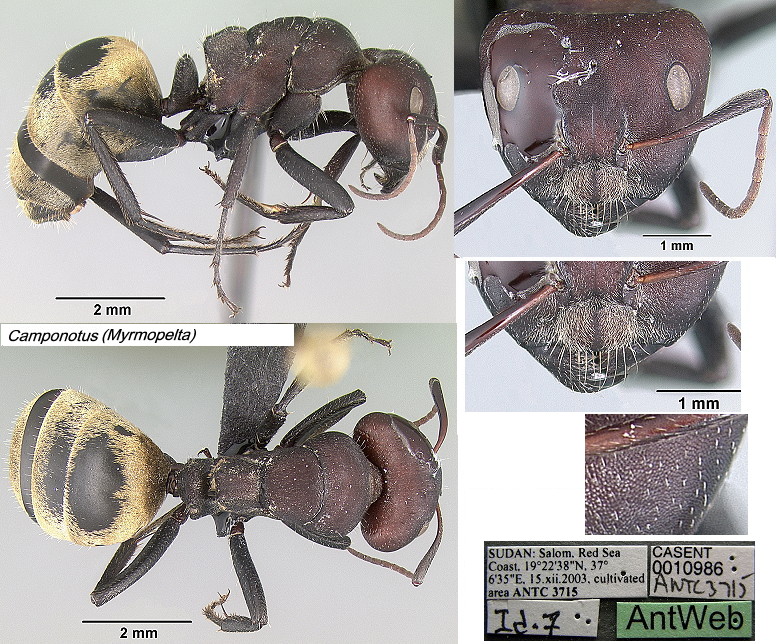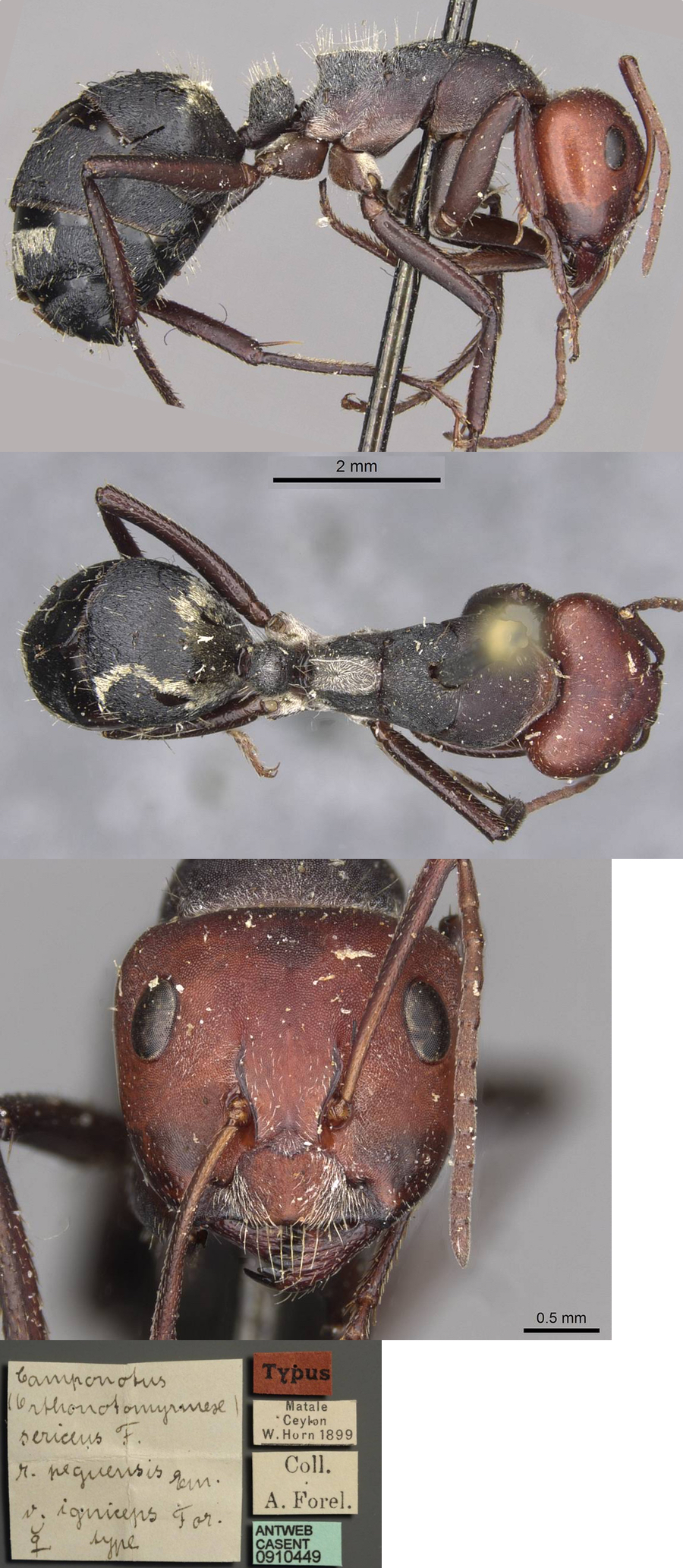Camponotus (Orthonotomyrmex) obtusus (F Smith) -
revived status
  see Iran page see Iran page
Type location Egypt (Formica obtusa,
Smith, F., 1858b, worker; synonymised with sericeus by Roger,
1863b: 2, a simple list) - no images on Antweb (September 2016).
|
Smith's description is at  - Notably relatively
short; head and alitrunk dull red; petiole node incrassate, i.e.
thickened, and apex emarginate; greater portion of the pubescence is
rubbed off [note the missing pubescence on the Sudan example, below] - Notably relatively
short; head and alitrunk dull red; petiole node incrassate, i.e.
thickened, and apex emarginate; greater portion of the pubescence is
rubbed off [note the missing pubescence on the Sudan example, below]  .
Note: the Antweb team do not appear to have located the type specimen
or that of sanguiniceps in
the BMNH. .
Note: the Antweb team do not appear to have located the type specimen
or that of sanguiniceps in
the BMNH. |
 The drawings (right)
from Mayr (1862) and Emery (1925b)
appear to show the obtusus shape of alitrunk and major and
minor heads respectively (the major head being much wider and squarer
and the minor head being more rectangular), and the drawing given for
an Indian example by Bingham (1903, below) shows the quite high and
slender petiole node (Bingham described it as "rounded, knob like").
For comparisons see Camponotus
(Orthonotomyrmex) sericeus. The drawings (right)
from Mayr (1862) and Emery (1925b)
appear to show the obtusus shape of alitrunk and major and
minor heads respectively (the major head being much wider and squarer
and the minor head being more rectangular), and the drawing given for
an Indian example by Bingham (1903, below) shows the quite high and
slender petiole node (Bingham described it as "rounded, knob like").
For comparisons see Camponotus
(Orthonotomyrmex) sericeus.
|
 Speculatively
variations include Speculatively
variations include
opaciventris
(Camponotus opaciventris n.
sp., Mayr, 1879: 648, worker; junior synonym Bingham, 1903: 376;
revived from synonymy as variety, Forel 1908a: 6, cited in Emery,
1925b: 126) India, collected at Calcutta by Rothney - no images
on Antweb (September 2016) - ? raised to species by Dietrich (2004)
igniceps (Camponotus (Orthonotomyrmex) sericeus
F. r. peguensis Em. v. igniceps n. v., Forel, 1913e: 664,
worker) Sri Lanka - see below
sanguiniceps (Camponotus
(Orthonotomyrmex) sericeus
F., var. sanguiniceps,
Donisthorpe, 1942d: 458, worker) South India - no images on
Antweb (September 2016)
puniceps (Camponotus
(Orthonotomyrmex?) puniceps
sp. n., Donisthorpe, 1942d: 458, worker) South India, Dohnavur,
Tinnevelly District - see bottom
pyrrhocephala (Formica
pyrrhocephala
Motsch., Motschoulsky, 1863: 11, worker) Sri Lanka, near
Colombo - no images on Antweb (September 2016).
Mayr (1862: 675) provided a detailed, illustrated
description of sericeus sensu lato, but curiously did not list
any African localities (other than Egypt), this is at  . Motschoulsky's (1863) description of pyrrhocephala
is at . Motschoulsky's (1863) description of pyrrhocephala
is at  . Mayr's (1879)
description of opaciventris is at . Mayr's (1879)
description of opaciventris is at  . Forel (1891b: 56)
provided a description and notes which seem to blanket both the sericeus
ss and obtusus forms, this is at . Forel (1891b: 56)
provided a description and notes which seem to blanket both the sericeus
ss and obtusus forms, this is at  . Bingham (1903: 376) provided a
description and notes, this is at . Bingham (1903: 376) provided a
description and notes, this is at  .
Donisthorpe's (1942d) descriptions are at .
Donisthorpe's (1942d) descriptions are at  . .
|
Forel (1913e) described igniceps - given to the
variety of peguensis
which had the head and antennae red in the queen and worker, with the
rest of the body black; The race peguensis has the pubescence
and general form of the typical sericeus and not the
characteristics of the race opaciventris Mayr.
Santschi (1926b) had - the type is entirely black, the
pelt of pubescence is greyish yellow
v obtusus Sm. - head red; alitrunk variable black or red; legs
brown; pubescence somewhat golden; petiole, scale less thick at summit
[from Egypt, Port Said by Karavaiev; from Obok, by Maindron, 1893; and
from Jansuame, Sahara, Iferouman Region, by Mission Fourreau-Lamy,
1900).
Donisthorpe's (1942d) description of sanguiniceps
was simply - "Some of these soldiers (from Dohnavur, 350 ft, Tinnevelly
District, S. India, 30.ix., 1 & 8.x.38) ... possess blood-red
heads, = var sanguiniceps Donis.". On puniceps, TL 8.5 mm, however, he
drew attention to the petiole (scale) being "not low, nor has it the
form of a round node".
Collingwood (1985: 282 and in key p 276), recording "C.
sericeus" from Saudi Arabia, noted that in profile the dorsal
outline of the alitrunk is interrupted by a deep metanotal groove; also
whole body densely sculptured, hairy and opaque; propodeum broadly
dentate. He added that it is a hardy, daytime forager and tends coccids
on trees and shrubs.
Dietrich (2004) reviewed the some of the various forms
listed above and concluded that some of the Middle Eastern specimens
and those from India were readily separable from Camponotus sericeus. He
re-described Camponotus opaciventris
Mayr, raising it to species, and described a new species, Camponotus husseini. While he
assessed the differences between husseini
and sericeus, he did not
present data on opaciventris
and gave images only of husseini.
Neither is among the Antweb images. There is no mention of Camponotus obtusus and the analysis
appears to ignore vasriation in proportions due to dimorphism, i.e.
major and minor workers.
Dietrich (2004) Taxonomische Beiträge zur Myrmekofauna
Jordaniens (Hymenoptera: Formicidae). Denisia,
14, 319-344.
|
Oxford University Museum
specimens
Camponotus (Orthonotomyrmex) obtusus
B Taylor det.
|
Saudi Arabia
M Sharaf
|
26.iv.2006
Farasan Is
16° 42' N
42° 11' E
|
Red Sea;
protectorate building
|
2
|
 |
Camponotus (Orthonotomyrmex) obtusus
B Taylor det. |
Sudan
Awatif Omer
46
|
2012
Al Musawart
16°32.66' N
33°46.71' E
|
Almoswart (near
Shandi, Shendi) E Musawwarat es Sufra in Nubian desert
Major & media workers
|
2
|
 |
|
Summary Description (comparision with sericeus
s.s).
MAJOR - head much wider than long; scapes more slender but apically
thicker; whole alitrunk relatively short; mesonotum profile sinuous
(evenly convex in sericeus); propodeum dorsum significantly
shorter than declivity; in profile propodeum dorsum is convex, from
above it is simply medially shallowly concave (sericeus has a
variable longitudinal carina); petiole thick but squamiform; erect
pilosity sparser, shorter and finer; sculpturation of head noticeably
coarser; much less pubescence on head (except clypeus) and alitrunk;
overall matt with only a low lustre; pubescence bright golden; general
colour dark red, near black on gaster, funiculi and tarsi lighter.
|
 The photomontage is of
a major worker from Sudan; collector Awatif Omer (2013.46. The photomontage is of
a major worker from Sudan; collector Awatif Omer (2013.46.
|
 The photomontage is of
a minor worker from Sudan; collector Awatif Omer (2013.46). The photomontage is of
a minor worker from Sudan; collector Awatif Omer (2013.46).
|
 The photomontage is of
a major worker from Saudi
Arabia, Farasan Islands, Red Sea, 42° 11' E, 16° 42' N;
protectorate building, collected by Mostafa Sharaf, 26.iv.2006. The photomontage is of
a major worker from Saudi
Arabia, Farasan Islands, Red Sea, 42° 11' E, 16° 42' N;
protectorate building, collected by Mostafa Sharaf, 26.iv.2006.
Note: assuming the Bingham (1903) scale to be one line =
2.117 mm, this is an exact match for his drawing of a major.
|
 The photomontage is of
a minor worker from Saudi
Arabia, as above, collected by Mostafa Sharaf. The photomontage is of
a minor worker from Saudi
Arabia, as above, collected by Mostafa Sharaf.
|
 The photomontage is of specimens originally photographed
in Egypt by Mostafa Sharaf; from Siwa oasis (Western desert) in 1996,
collected by Dr.Ahmed Saad, Professor of Insect Behaviour, Faculty of
Science, Ain Shams University, Cairo The photomontage is of specimens originally photographed
in Egypt by Mostafa Sharaf; from Siwa oasis (Western desert) in 1996,
collected by Dr.Ahmed Saad, Professor of Insect Behaviour, Faculty of
Science, Ain Shams University, Cairo
|
 The photomontage is
collated from http://www.antweb.org/specimen.do?name=casent0010986
Collection Information: Specimen Code CASENT0010986; Locality Sudan:
Salom, Red Sea Coast; 19°22'38"N 037°06'35"E; Collection codes:
ANTC3715; Date: 15 Dec 2003; Collected by: H. Eriksson; Habitat:
cultivated area, irrigated area. The photomontage is
collated from http://www.antweb.org/specimen.do?name=casent0010986
Collection Information: Specimen Code CASENT0010986; Locality Sudan:
Salom, Red Sea Coast; 19°22'38"N 037°06'35"E; Collection codes:
ANTC3715; Date: 15 Dec 2003; Collected by: H. Eriksson; Habitat:
cultivated area, irrigated area.
|
 The photomontage of the type major (?) worker of igniceps
from Sri Lanka is collated from http://www.antweb.org/specimen.do?name=casent0910449. The photomontage of the type major (?) worker of igniceps
from Sri Lanka is collated from http://www.antweb.org/specimen.do?name=casent0910449.
|
 The photomontage of a
minor worker of puniceps from India is collated from http://www.antweb.org/specimen.do?name=casent0903577. The photomontage of a
minor worker of puniceps from India is collated from http://www.antweb.org/specimen.do?name=casent0903577.
|
 The photomontage of a
minor worker from India is collated from http://www.antweb.org/specimen.do?name=casent0280276. The photomontage of a
minor worker from India is collated from http://www.antweb.org/specimen.do?name=casent0280276.
|
|